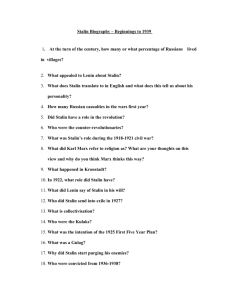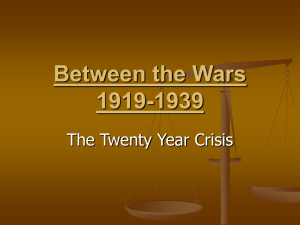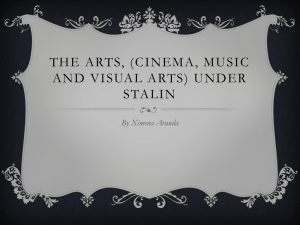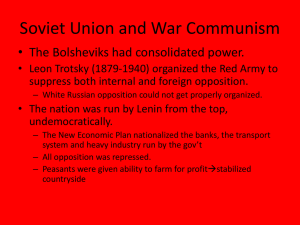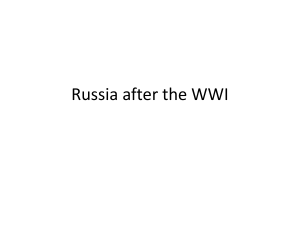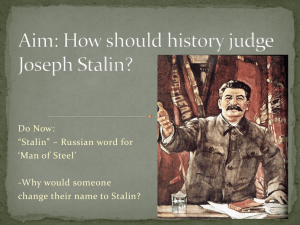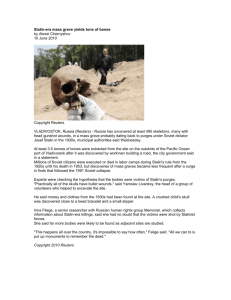Simon-Crowley-Show-trials.doc
advertisement
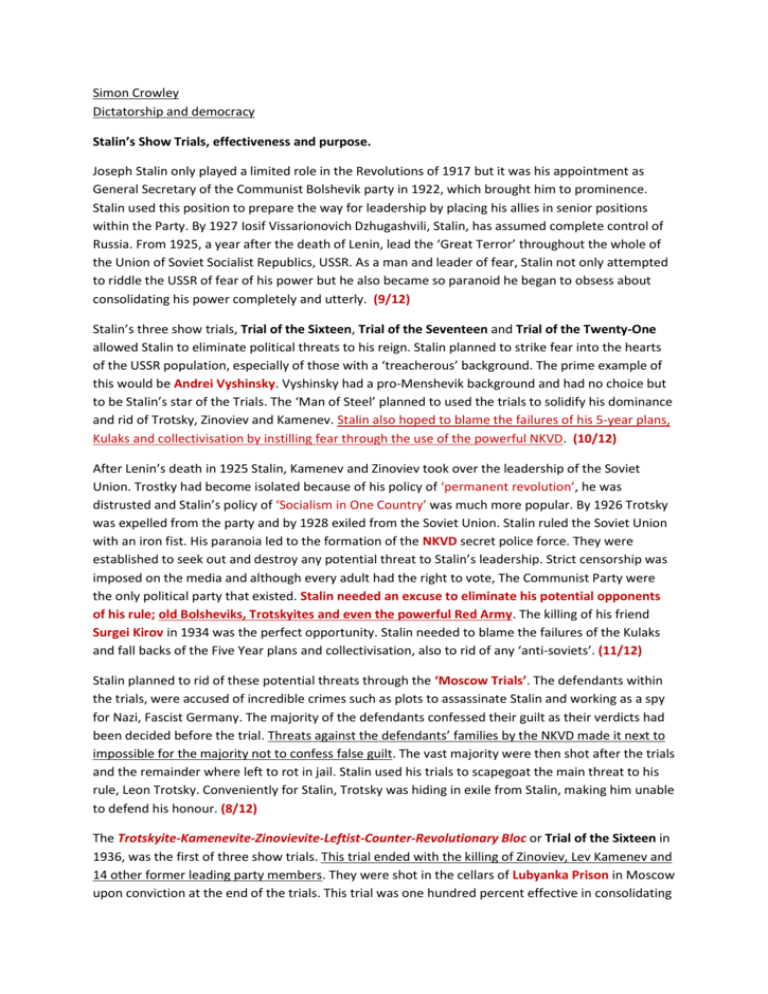
Simon Crowley Dictatorship and democracy Stalin’s Show Trials, effectiveness and purpose. Joseph Stalin only played a limited role in the Revolutions of 1917 but it was his appointment as General Secretary of the Communist Bolshevik party in 1922, which brought him to prominence. Stalin used this position to prepare the way for leadership by placing his allies in senior positions within the Party. By 1927 Iosif Vissarionovich Dzhugashvili, Stalin, has assumed complete control of Russia. From 1925, a year after the death of Lenin, lead the ‘Great Terror’ throughout the whole of the Union of Soviet Socialist Republics, USSR. As a man and leader of fear, Stalin not only attempted to riddle the USSR of fear of his power but he also became so paranoid he began to obsess about consolidating his power completely and utterly. (9/12) Stalin’s three show trials, Trial of the Sixteen, Trial of the Seventeen and Trial of the Twenty-One allowed Stalin to eliminate political threats to his reign. Stalin planned to strike fear into the hearts of the USSR population, especially of those with a ‘treacherous’ background. The prime example of this would be Andrei Vyshinsky. Vyshinsky had a pro-Menshevik background and had no choice but to be Stalin’s star of the Trials. The ‘Man of Steel’ planned to used the trials to solidify his dominance and rid of Trotsky, Zinoviev and Kamenev. Stalin also hoped to blame the failures of his 5-year plans, Kulaks and collectivisation by instilling fear through the use of the powerful NKVD. (10/12) After Lenin’s death in 1925 Stalin, Kamenev and Zinoviev took over the leadership of the Soviet Union. Trostky had become isolated because of his policy of ‘permanent revolution’, he was distrusted and Stalin’s policy of ‘Socialism in One Country’ was much more popular. By 1926 Trotsky was expelled from the party and by 1928 exiled from the Soviet Union. Stalin ruled the Soviet Union with an iron fist. His paranoia led to the formation of the NKVD secret police force. They were established to seek out and destroy any potential threat to Stalin’s leadership. Strict censorship was imposed on the media and although every adult had the right to vote, The Communist Party were the only political party that existed. Stalin needed an excuse to eliminate his potential opponents of his rule; old Bolsheviks, Trotskyites and even the powerful Red Army. The killing of his friend Surgei Kirov in 1934 was the perfect opportunity. Stalin needed to blame the failures of the Kulaks and fall backs of the Five Year plans and collectivisation, also to rid of any ‘anti-soviets’. (11/12) Stalin planned to rid of these potential threats through the ‘Moscow Trials’. The defendants within the trials, were accused of incredible crimes such as plots to assassinate Stalin and working as a spy for Nazi, Fascist Germany. The majority of the defendants confessed their guilt as their verdicts had been decided before the trial. Threats against the defendants’ families by the NKVD made it next to impossible for the majority not to confess false guilt. The vast majority were then shot after the trials and the remainder where left to rot in jail. Stalin used his trials to scapegoat the main threat to his rule, Leon Trotsky. Conveniently for Stalin, Trotsky was hiding in exile from Stalin, making him unable to defend his honour. (8/12) The Trotskyite-Kamenevite-Zinovievite-Leftist-Counter-Revolutionary Bloc or Trial of the Sixteen in 1936, was the first of three show trials. This trial ended with the killing of Zinoviev, Lev Kamenev and 14 other former leading party members. They were shot in the cellars of Lubyanka Prison in Moscow upon conviction at the end of the trials. This trial was one hundred percent effective in consolidating fear throughout the USSR. International media were present for the three show trials and could not understand why the accused continuously pleaded guilty. Stalin awarded the NKVD powers of torture. This torture and threatening of the accused families lead to them all pleading guilty, of increasingly ridiculous crimes. The trials were carefully stage-managed and held in the October Hall. The spectators were mainly plain-clothed NKVD and journalists of foreign countries. To add to the humiliation of the accused they were dressed in ill-fitting and old clothes. The NKVD guarded the accused with fixed bayonets; this was to reinforce their guilt. The Trial of the Sixteen was a focus on the Trotskyite-Kamenevite-Zinovievite-Leftist-Counter-Revolutionary Bloc , it was alleged that Trotsky, Zinoviev and Kamenev had killed Kirov and had attempted to take Stalin’s life. (10/12) The second show trial came in 1937, the Anti-Soviet Trotskyite-Centre or Trial of the Seventeen. The most prominent of those accused was Karl Radek. Radek was the Soviet Union’s leading political writer at the time. Radek was also a former supporter of Trotsky while the others charged were mainly leaders in the industrialisation drive. Just like the first trial the defendants fell over each other to plead guilty. Also like the first trial the accusations were ridiculous, examples being conspiring with Nazi Germany and Japan, both leading fascist powers at the time. This was remarkable as the fascist regimes were extremely anti-Semitic and many of the 17 defendants were in fact, Jewish. (8/12) Between 1934 and 1936, while the first show trial took place, Stalin began the purge of the lower ranks of the party. The NKVD imprisoned or shot hundreds of thousands of party activists. Many were sent to forced-labour camps called Gulags. Few survived the harsh conditions. These first two trials and purge of the party were extremely effective in consolidating fear and thus Stalin’s power. In March 1938, the rial of the Bloc of Rightists and Trotskyites or Trial of the Twenty-One took place. The third and final of the three show trials was the Trial of the Twenty-One. The highest ranking party members were executed following this trial including, Nikolai Bukharin, a leading Soviet scholar, Aleksei Rykov, the Chairman of the Council of People’s Commissars and HG Yagoda, a former head of the secret police. Just like the two previous show trials the defendants were accused of ridiculous crimes. These included murdering Lenin two decades before, murdering Kirov and spying for Britain, France, Japan and Germany. The evidence was weak and poorly argued but the accused pleaded guilty again and again. This was the case in all the defendants except one, Nikolai Kretinsky. He pleaded innocent and said he had never heard of the Bloc of Rights and Trotskyites. After a night with the NKVD he dramatically changed his mind. International media had kept a close eye on three show trials and found it hard to believe the defendants all pleaded guilty of such ridiculous crimes. They amazed the western media. Their shocked reaction was reflected in the newspapers. Despite the lack of and weakness of evidence, the US ambassador was convinced the defendants were guilty and wrote that most diplomats agree. (11/12) In between the second and third show trial Stalin began a widespread purge of the army, his actions are hard to find reason for but it is my belief that Stalin may have thought it was necessary to remove any officers whose loyalty was in doubt, especially after the army mutiny. According to figures published the army officers were purged of 35,000 men, 3 marshals, 50 Corps Commanders and 154 Divisional Commanders. By 1939, of the original 15-man Bolshevik government of 1917, only two were still alive, Stalin and Trotsky. During the Show Trials ten had perished, this shows the effectiveness of the trials and how Stalin hoped to rid of any threats to his power. In 1940 Trotsky was gunned down in Mexico by one of Stalin’s men, leaving Stalin the only survivor. Stalin was now the absolute master of the communist party, and of the USSR. The Show Trials were instrumental in his ‘Great Terror’ and extremely beneficial to Stalin. The purging of the Red Army left it weakened and unprepared for WW2, Stalin’s paranoia was to blame for this. The purges of the army led to the difficulties during the Russian – Finish War 1939-1940. The purges and Show trials brought the Communist System into disrepute. It wasn’t until 1956 that the leadership of the Soviet Union denounced the crimes of Stalin. (10/12) CM = 9 + 10 + 11 + 8 + 10 + 8 + 11 + 10 = 60/60 OE = 38/40 Overall = 98/100


